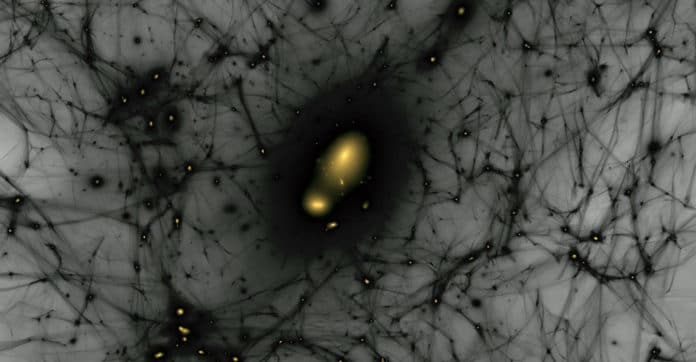In our solar system, planets have their satellites. Like those, our galaxy has its satellite galaxies, and some of those might have smaller satellite galaxies of their own. Dark matter is believed to be responsible for much of such structure.
Presently, researchers at the Department of Energy’s SLAC National Accelerator Laboratory and the Dark Energy Survey have drawn on perceptions of faint galaxies around the Milky Way to put more tightly imperatives on the association between the size and structure of galaxies and the dark matter halos that encompass them.
They discovered more evidence for the existence of LMC satellite galaxies and made a new prediction: On the off chance that the scientists’ models are right, the Milky Way ought to have an extra at least 150 faint satellite galaxies anticipating revelation by cutting edge projects, for example, the Vera C. Rubin Observatory’s Legacy Survey of Space and Time.
The study is the part of the effort to comprehend the working of dark matter on scales smaller than our galaxy.
Large Magellanic Cloud is one of the satellite galaxies of the Milky Way. Sloan Digital Sky Survey (SDSS) in the early 2000s, suggested that the number must be around just a dozen or so. The survey then gives rise to more discoveries, and as a result, the number of observed satellite galaxies has risen dramatically. More recent discoveries by projects including the Dark Energy Survey (DES), the number of known satellite galaxies has climbed to about 60.
Risa Wechsler, director of KIPAC, said, “Such discoveries are always exciting, but what’s perhaps most exciting is what the data could tell us about the cosmos. For the first time, we can look for these satellite galaxies across about three-quarters of the sky, and that’s important to several different ways of learning about dark matter and galaxy formation.”
“Last year, for example, scientists used data on satellite galaxies in conjunction with computer simulations to place much tighter limits on dark matter’s interactions with ordinary matter.”
Now, scientists using data from a comprehensive search over most of the sky to ask different questions, including how much dark matter it takes to form a galaxy, how many satellite galaxies we should expect to find around the Milky Way and whether galaxies can bring their satellites into orbit around our own – a key prediction of the most popular model of dark matter.
To study the LMC’s satellites more thoroughly, scientists analyzed computer simulations of millions of possible universes. Those simulations model the formation of dark matter structure that permeates the Milky Way, including details such as smaller dark matter clumps within the Milky Way that are expected to host satellite galaxies.
Later, scientists used a flexible model to connect dark matter to galaxy formation. The model allowed them to represent vulnerabilities in the present comprehension of galaxy formation, including the relationship between galaxies’ brightness and the mass of dark matter clumps inside which they form.
An effort led by the others in the DES team, including former KIPAC students Alex Drlica-Wagner, a Wilson Fellow at Fermilab and an assistant professor of astronomy and astrophysics at the University of Chicago, and Keith Bechtol, an associate professor of physics at the University of Wisconsin-Madison, and their collaborators produced the crucial final step: a model of which satellite galaxies are most likely to be seen by current surveys, given where they are in the sky as well as their brightness, size, and distance.
Scientists ran their model using several parameters and searched for simulations in which LMC-like objects fell into the gravitational pull of a Milky Way-like galaxy. They then compared those cases with galactic observations.
Ethan Nadler, the study’s first author and a graduate student at the Kavli Institute for Particle Astrophysics and Cosmology (KIPAC) and Stanford University said, “The results were consistent with Gaia observations: Six satellite galaxies should currently be detected in the vicinity of the LMC, moving with roughly the right velocities and in roughly the same places as astronomers had previously observed. The simulations also suggested that the LMC first approached the Milky Way about 2.2 billion years ago, consistent with high-precision measurements of the motion of the LMC from the Hubble Space Telescope.”
The study has put limits on the association between dark matter halos and galaxy structure. What’s more, the extrapolation of the model suggests that the faintest galaxies that could ever be observed could form in halos up to a hundred times less massive than that.
Nadler said, “Although, more discoveries are yet to come. If the simulations are correct, there are around 100 more satellite galaxies – more than double the number already discovered – hovering around the Milky Way.”
The study was conduction in collaboration between the Dark Energy Survey, led by the Milky Way Working Group, with substantial contributions from junior members including Sidney Mau, an undergraduate at the University of Chicago, and Mitch McNanna, a graduate student at UW-Madison. The research was supported by a National Science Foundation Graduate Fellowship, by the Department of Energy’s Office of Science through SLAC, and by Stanford University.
Journal Reference:
- Milky Way Satellite Census — II. Galaxy-Halo Connection Constraints Including the Impact of the Large Magellanic Cloud. https://arxiv.org/abs/1912.03303
